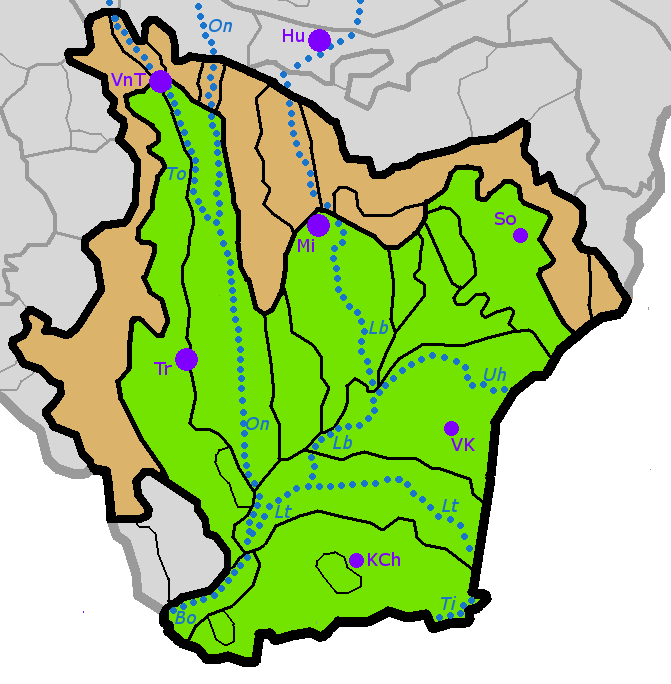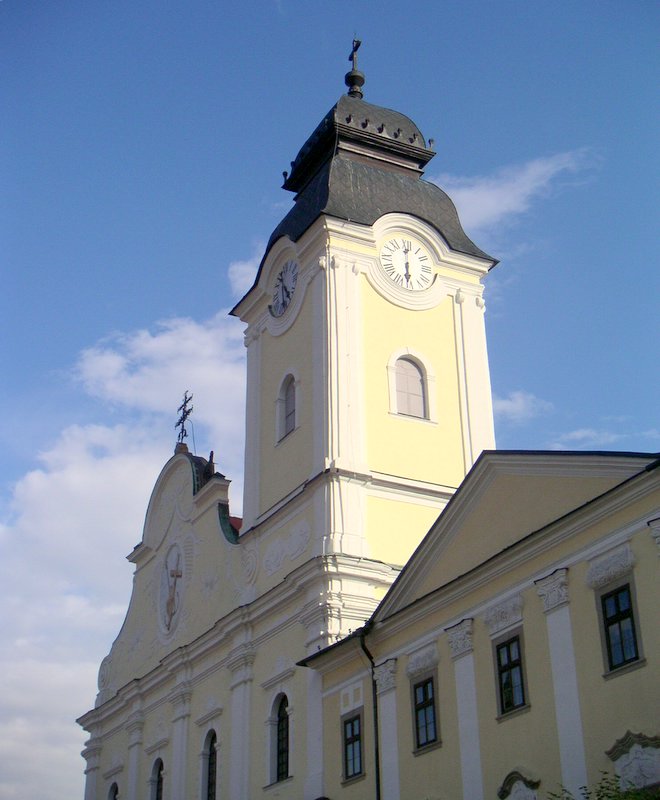|
Prešov Region
The Prešov Region (, ; ), also Priashiv Region (, ), is one of the eight Slovak administrative regions and consists of 13 districts (okresy) and 666 municipalities, 23 of which have town status. The region was established in 1996 and is the most populous of all the regions in Slovakia. Its administrative center is the city of Prešov. Geography It is located in the north-eastern Slovakia and has an area of 8,975 km2. The region has a predominantly mountainous landscape. The subdivisions of Tatras – High Tatras and Belianske Tatras lie almost entirely in the region and include the highest point of Slovakia – Gerlachovský štít (2,654 ASL). Other mountain ranges and highlands in the region are Šarišská vrchovina, Čergov, Ondavská vrchovina, Slanské vrchy, Pieniny, Levoča Hills, Laborecká vrchovina, Bukovské vrchy, Vihorlat Mountains and Eastern Slovak Lowland. The basins in Prešov Region are Podtatranská kotlina, Hornádska kotlina and Košic ... [...More Info...] [...Related Items...] OR: [Wikipedia] [Google] [Baidu] |
Regions Of Slovakia
Since 1949 (except 1990–1996), Slovakia has been divided into a number of (singular ; usually translated as "Regions" with capital R). Their number, borders and functions have been changed several times. There are eight regions of Slovakia and they correspond to the European Union, EU's Nomenclature of Territorial Units for Statistics, NUTS 3 level of local administrative units. Each kraj consists of (counties or districts), which are further divided into (municipalities). There are 79 Districts of Slovakia, districts. List After a period without kraje and without any equivalent (1990–1996), the kraje were reintroduced in 1996. As for administrative division, Slovakia has been subdivided into 8 kraje since 24 July 1996: Since 2002, Slovakia is divided into 8 (self-governing regions), which are called by the Constitution (Higher Territorial Units), abbr. VÚC. The territory and borders of the self-governing regions are identical with the territory and borders of the ... [...More Info...] [...Related Items...] OR: [Wikipedia] [Google] [Baidu] |
Gerlachovský štít
Gerlachovský štít (, translated into English as ''Gerlachov Peak'', German: ''Gerlsdorfer Spitze'', Hungarian: ''Gerlachfalvi-csúcs''), informally referred to as Gerlach, is the highest peak in the High Tatras, in Slovakia, and in the Carpathian Mountains. Its elevation is usually listed at 2654.4 m above mean sea level. The mountain features a vertical rise of approximately above the valley floor. Mistaken for an average mountain in the rugged High Tatras range in the more distant past, it has since played a symbolic role in the eyes of the rulers and populations of several Central European nations, to the point that between the 19th and mid-20th century, it had four different names with six name reversals. Due to geopolitical changes, it was successively the highest mountain of the Kingdom of Hungary, and of Czechoslovakia, Slovakia and then Czechoslovakia again within the span of less than three decades of the 20th century. Gerlachovský štít shares its geology and eco ... [...More Info...] [...Related Items...] OR: [Wikipedia] [Google] [Baidu] |
Košice Basin
Košice is the largest city in eastern Slovakia. It is situated on the river Hornád at the eastern reaches of the Slovak Ore Mountains, near the border with Hungary. With a population of approximately 230,000, Košice is the second-largest city in Slovakia, after the capital Bratislava. Being the economic and cultural centre of eastern Slovakia, Košice is the seat of the Košice Region and Košice Self-governing Region, it belongs to the Košice-Prešov agglomeration, and is home to the Slovak Constitutional Court, three universities, various dioceses, and many museums, galleries, and theatres. In 2013, Košice was the European Capital of Culture, together with Marseille, France. Košice is an important industrial centre of Slovakia, and the U.S. Steel Košice steel mill is the largest employer in the city. The town has extensive railway connections and an international airport. The city has a preserved historical centre which is the largest among Slovak towns. There ar ... [...More Info...] [...Related Items...] OR: [Wikipedia] [Google] [Baidu] |
Podtatranská Kotlina
The Podtatranská kotlina (literally Sub-Tatra Basin or Basin under Tatra(s)) is a basin in northern Slovakia, part of the Fatra-Tatra Area, which belongs to the Inner Western Carpathians. Towns and cities include Ružomberok, Liptovský Mikuláš, Liptovský Hrádok, Svit, Poprad, Kežmarok, Spišská Belá and Podolínec. Location and characteristics The Podtatranská kotlina is oriented on an east–west axis and is around long and around wide in the north–south direction. It borders: * Tatras in the north * Spišská Magura in the north-east * Levoča Hills in the east *Kozie chrbty in the south-east * Low Tatras in the south *Greater Fatra in the south-west * Choč Mountains in the north-west The basin is divided into three sub-divisions: ''Liptovská kotlina'' (Liptov Basin), ''Popradská kotlina'' (Poprad Basin) and ''Tatranské predhorie'', also called ''podhorie'' (Tatra Piedmont). The border between the former named basins is also the drainage divide; the V ... [...More Info...] [...Related Items...] OR: [Wikipedia] [Google] [Baidu] |
Eastern Slovak Lowland
The East(ern) Slovak Lowland ( Slovak: ''Východoslovenská nížina'') is the name of a part of the Great Hungarian Plain (Slovak: ''Veľká dunajská kotlina'') situated in Slovakia. In terms of geomorphology, it forms one unit together with the Tisza Lowland (''Tiszamenti síkság'') in Hungary, the Transcarpathian Lowland (''Zakarpats'ka nyzovyna'') in Ukraine, and the plain ''Câmpia Someşului'' in Romania Romania is a country located at the crossroads of Central Europe, Central, Eastern Europe, Eastern and Southeast Europe. It borders Ukraine to the north and east, Hungary to the west, Serbia to the southwest, Bulgaria to the south, Moldova to .... It consists of the following two parts: * Eastern Slovak Hills (also translated as Eastern Slovak Upland) in the west and the north; and * Eastern Slovak Flat (also translated as Eastern Slovak Plain) in the middle, east and south. References {{Authority control Plains of Slovakia Pannonian Plain ... [...More Info...] [...Related Items...] OR: [Wikipedia] [Google] [Baidu] |
Vihorlat Mountains
Vihorlat Mountains (; , ''Vyhorliat,'' Hungarian: Vihorlát) or colloquially Vihorlat is a volcanic mountain range in eastern Slovakia and western Ukraine. A part of the range is listed as a World Heritage Site. Etymology The name is of Slavic origin. Jozef Martinka suggested the origin in Ruthenian ''vyharj / vyhar'' ( Slovak: ''výhor'') - a burned forest with a grouping suffix ''-ať''. ''Vygarljať'', ''Vyhorljať'' - a mountain with many burned places. The Hungarian name ''Vihorlát'' derives from Slovak as an intermediate language. Vihorlat Mountains in Slovakia The Slovak part is 55 km long, up to 11 km broad and from 400 to 1,076 m high. It belongs to the Vihorlat-Gutin Area group of the Inner Eastern Carpathian Mountains. The middle part of the mountains is protected by the Vihorlat Protected Landscape Area. Vihorlat is bordered by the Eastern Slovak Lowland (''Východoslovenská nížina'') in the south and the west. The Beskidian Southern Piedm ... [...More Info...] [...Related Items...] OR: [Wikipedia] [Google] [Baidu] |
Bukovské Vrchy
The Bukovec Mountains (; ) is a flysch mountain range in north-eastern Slovakia, part of the Eastern Beskids of the Outer Eastern Carpathians. It is located in the Prešov Region near the borders with Poland (Bieszczady Mountains) and Ukraine, and adjacent to the Laborec Highlands. The highest mountain is at 1,221 m AMSL. Original flora and fauna was preserved because of the area's remoteness. The mountain range is covered with beech forests. The area is protected by Poloniny National Park. Localities Havešová, Stužica and Rožok are listed on the UNESCO World Heritage Site World Heritage Sites are landmarks and areas with legal protection under an treaty, international treaty administered by UNESCO for having cultural, historical, or scientific significance. The sites are judged to contain "cultural and natural ... list. External linksImages at Hiking.sk [...More Info...] [...Related Items...] OR: [Wikipedia] [Google] [Baidu] |
Laborecká Vrchovina
The Laborec Highlands (in Slovak, ''Laborecká vrchovina'') is a mountain range in northeastern Slovakia, part of the Lower Beskids of the Outer Eastern Carpathians. The range is composed of Carpathian flysch. Bordered in the north by the Polish national border and to the west by the Ondavská Highlands, its ridges typically reach a height of 500 to 700 metres. The highest point is ''Vysoký Grúň'', at 905 metres. The region is drained by the Laborec River and, in its western portion, by the Ondava. Notables town and villages in the hill country include Medzilaborce (site of the Andy Warhol Museum of Modern Art), Vyšná Jablonka, Bodružal, and Vyšný Komárnik. The highlands are also the location of the strategically significant Dukla Pass, the lowest mountain pass in the main ranges of the Carpathians, and the site of the Battle of the Dukla Pass The Battle of the Dukla Pass, also known as the Dukla, Carpatho–Dukla, Rzeszów–Dukla, or Dukla–Prešov offensive, ... [...More Info...] [...Related Items...] OR: [Wikipedia] [Google] [Baidu] |
Levoča Hills
Levoča (; ; ) is the principal town of Levoča District in the Prešov Region of eastern Slovakia, with a population of 14,256. The town has a historic center with a well-preserved town wall, a Gothic church with the tallest wooden altar in the world, carved by Master Pavol of Levoča, and many other Renaissance buildings. On 28 June 2009, Levoča was added by UNESCO to its World Heritage List. Geography Levoča lies at an altitude of above sea level and covers an area of . It is located in the northern part of the Hornád Basin at the foothills of the Levoča Hills, at the stream ''Levočský potok'', a tributary of Hornád. Poprad is away to the west, Prešov to the east, Košice to the southeast and Bratislava to the southwest. Nearby settlements include: *Levočská Dolina (=English: Levoča Valley). About out of town, on the way to Závada. *Levočské Lúky (=English: Levoča Fields). Settlement on the road to Spišska Nová Ves. *Závada. Village in the hills ab ... [...More Info...] [...Related Items...] OR: [Wikipedia] [Google] [Baidu] |
Pieniny
The Pieniny (sometimes also the PieninsSzafer, Władysław. 2013. ''The Vegetation of Poland: International Series of Monographs in Pure and Applied Biology''. Warsaw: Pergamon Press, pp. 156, 388. or the Pienin Mountains,Griffiths, Graham C. D. 1976. Studies on Boreal Agromyzidae (Diptera). XII. ''Phytomyza'' and ''Chromatomyia'' miners on Astereae (Compositae).''Quaestiones Entomologicae'' 12: 239–275, p. 255. ) is a mountain range in the south of Poland and the north of Slovakia. It is classified within the eastern section of the Western Beskids. The Pieniny mountain range is divided into three parts – ''Pieniny Spiskie'' () and ''Pieniny Właściwe'' (Slovak: ''Centrálne Pieniny'') in Poland; and, ''Małe Pieniny'' (; ) in Poland and Slovakia. The Pieniny mountains consist mainly of beds of limestone and dolomite. The most famous peak, ''Trzy Korony'' (Three Crowns), is 982 metres high. It is also the summit of the Three Crowns Massif. Pieniny's highest peak &ndas ... [...More Info...] [...Related Items...] OR: [Wikipedia] [Google] [Baidu] |



